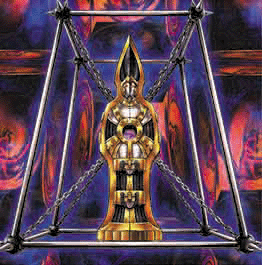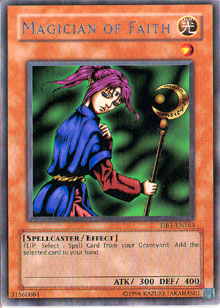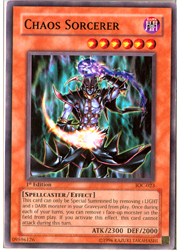Once in a blue moon, the makers of the Yu-Gi-Oh! TCG introduce a card so arrestingly powerful that it becomes the centerpiece of a brand-new theme. Cards like Limiter Removal, which gave rise to the Machine archetype, Strike Ninja, which provided the fundamental link to a Dark-type deck, and the Chaos monsters are all famous for their balance and impact on the metagame.
The bottom line is that the game is designed to provide bonuses to those players who choose to use all monsters of the same subtype. Two of the best examples of well-designed subtype themes are Zombies and Gravekeepers (which are technically Spellcasters). Zombies have access to the best searcher in the game (Pyramid Turtle), more recursion than any other build (Book of Life), and great synergistic monsters like Spirit Reaper and Vampire Lord. Gravekeepers get a net +500 ATK and DEF boost through Necrovalley, have the only card in the game that provides a significant +1 to the field (Gravekeeper’s Spy), and have Rite of Spirit, which is sort of like a version of Call of the Haunted that doesn’t need to stick around.
Historically, however, the three most supported subtypes in terms of sheer weight have been Warriors, Fiends, and Spellcasters. Warriors have the best searching card in the game, Reinforcement of the Army, which single-handedly makes the theme viable. Throw in support cards like The Warrior Returning Alive and even support monsters like Freed the Matchless General, Command Knight, and Marauding Captain, and it’s not hard to see that they have always been in the top tier.
On the other hand, Fiends have numerous searchable monsters that work well with one of the best monsters in the game, Mystic Tomato, while also packing a game-breaking special summon, in the form of Dark Necrofear. Throw in some of the best tribute monsters in the game, and you have a bona-fide contender. If regular Fiends don’t appeal, you can even run an Archfiend deck! The point, of course, is that subtypes should always be strengthened with great support cards. If the game provides no incentive to use monsters of a similar theme, cookie-cutter decks using a single copy of each restricted card rise to the forefront, as shown by the metagame that was present before the October Forbidden list.
A Brief History of Spellcasters
 Enter the Spellcaster subtype. Boasting the most monsters of any subtype in the entire game, Spellcasters have been searching nearly forever for a card that does justice to their combined might. I stated in my article about Dark Magician Girl that there are precious few incentives to running an all-Spellcaster deck. While that statement was true at the time, is no longer true. The release of Magical Dimension in the new Spellcaster’s Judgment Structure Deck has provided the missing link and driving impetus for all duelists to begin using Spellcasters competitively! Being responsible for the salvation of an entire archetype is quite a weighty matter, and Magical Dimension approaches its task seriously. It begs for you to take a look at its effect. It’s a quick-play spell, and its effect looks like this: “You can only activate this card while there is a face-up Spellcaster-Type monster(s) on your side of the field. Tribute 1 monster on your side of the field and Special Summon 1 Spellcaster-Type monster from your hand. Then you can destroy 1 monster on the field.”
Enter the Spellcaster subtype. Boasting the most monsters of any subtype in the entire game, Spellcasters have been searching nearly forever for a card that does justice to their combined might. I stated in my article about Dark Magician Girl that there are precious few incentives to running an all-Spellcaster deck. While that statement was true at the time, is no longer true. The release of Magical Dimension in the new Spellcaster’s Judgment Structure Deck has provided the missing link and driving impetus for all duelists to begin using Spellcasters competitively! Being responsible for the salvation of an entire archetype is quite a weighty matter, and Magical Dimension approaches its task seriously. It begs for you to take a look at its effect. It’s a quick-play spell, and its effect looks like this: “You can only activate this card while there is a face-up Spellcaster-Type monster(s) on your side of the field. Tribute 1 monster on your side of the field and Special Summon 1 Spellcaster-Type monster from your hand. Then you can destroy 1 monster on the field.”
Its quick-play spell status immediately creates huge ramifications. Imagine if your opponent uses a piece of spell or trap removal such as Mystical Space Typhoon or Heavy Storm to destroy it from your field. Provided you have a Spellcaster, the effect can chain, leading to minus one card advantage for your opponent! And in sheer advantage terms, the spell sacrifices one of your monsters to destroy one of your opponent’s while also allowing you to maintain your field presence. The effect requires a Spellcaster in hand and on the board, but a deck that’s focused on Spellcasters should not have a problem using this effect.
 However, the spell truly becomes incredible when you start considering other factors,. For example, what if we could mitigate the initial tribute cost? Notice that the text says you need a Spellcaster on the field to activate it, but the tributed monster can be anything! For example, you can use a spent Magician of Faith, Old Vindictive Magician, Apprentice Magician, or Breaker the Magical Warrior. Even more incredible, you can use Sheep tokens from Scapegoat or tokens from Stray Lambs to get the effect through. Simply get a Spellcaster on the field, and all of your spent flip effect monsters can be used to great effect.
However, the spell truly becomes incredible when you start considering other factors,. For example, what if we could mitigate the initial tribute cost? Notice that the text says you need a Spellcaster on the field to activate it, but the tributed monster can be anything! For example, you can use a spent Magician of Faith, Old Vindictive Magician, Apprentice Magician, or Breaker the Magical Warrior. Even more incredible, you can use Sheep tokens from Scapegoat or tokens from Stray Lambs to get the effect through. Simply get a Spellcaster on the field, and all of your spent flip effect monsters can be used to great effect.
The tribute portion has great synergy with a number of weaker flip effects that also happen to be Spellcasters. The aforementioned Apprentice Magician can be used to give Breaker a counter, then sacrificed. Gravekeeper’s Spy can both fulfill the initial requirement and also provide a free sacrifice for the effect. Magician of Faith and Old Vindictive Magician are basically useless after their effects resolve, so both of those monsters will cost you nothing.
Now you’ve turned the card into a far better trade-off! Next, think of the Spellcasters that you can summon with the effect. If you bring out a tribute monster like Dark Magician, Chaos Command Magician, or Dark Magician of Chaos, you don’t have to pay a tribute cost! This obviously means the field will be completely yours, since nothing can presumably take down a monster with 2400 ATK or more. The simple fact is that Magical Dimension can lead to huge life point swings by virtue of the fact that you’re special summoning a monster and simultaneously clearing your opponent’s defenses. Cards like Injection Fairy Lily and the aforementioned tribute monsters will create huge swings of life point loss. Throw in the fact that it helps you achieve the Sage’s Stone combo more easily, and you have a super-Spellcaster tool.
 The card also doubles as both face-up and face-down monster removal. With a card like Chaos Sorcerer or Old Vindictive Magician, you can clear an opponent’s entire board most of the time and have a monster to immediately attack with! Because Nobleman of Crossout is restricted, it has become very difficult to stop game-breaking flip effects like those of Morphing Jar, Cyber Jar, and Magician of Faith. Now, however, you can use Magical Dimension to clear face-down monsters as well as face-up ones! This type of awesome versatility is highly admired by top-tier duelists, and Magical Dimension has seen heavy use in the Japanese metagame because of this quality.
The card also doubles as both face-up and face-down monster removal. With a card like Chaos Sorcerer or Old Vindictive Magician, you can clear an opponent’s entire board most of the time and have a monster to immediately attack with! Because Nobleman of Crossout is restricted, it has become very difficult to stop game-breaking flip effects like those of Morphing Jar, Cyber Jar, and Magician of Faith. Now, however, you can use Magical Dimension to clear face-down monsters as well as face-up ones! This type of awesome versatility is highly admired by top-tier duelists, and Magical Dimension has seen heavy use in the Japanese metagame because of this quality.
The savvy player will devise all sorts of tricks for maximizing this card’s efficiency. For example, let’s assume that your monster is attacking an opponent’s, and he activates Sakuretsu Armor. You can chain your new quick-play Magical Dimension from your hand, sacrifice the monster that would have been destroyed by Sakuretsu Armor anyways, summon a replacement, and destroy the monster that Sakuretsu Armor was supposed to save! Is this a gorgeous combo or a luscious one? I don’t know!
Imagine using incredible Spellcasters off the original Magical Dimension to generate card advantage. Don’t be shy—go ahead and drop that Masked Sorcerer to generate some card advantage. Play that Magical Dimension on your opponent’s set monster in the end phase, bringing out Toon Gemini Elf, and watch it be able to attack on your turn! If the opponent plays Smashing Ground on your Mobius the Frost Monarch, you can use the card on another monster to bring out Peten the Dark Clown. The possibilities are endless.
The Spellcaster’s Judgment Structure Deck is a beautiful addition to the Yu-Gi-Oh! environment. Here’s hoping to see a Spellcaster-themed deck in the finals of a Shonen Jump Championship near you!